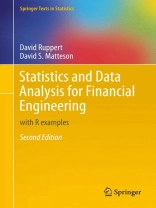The new edition of this influential textbook, geared towards graduate or advanced undergraduate students, teaches the statistics necessary for financial engineering. In doing so, it illustrates concepts using financial markets and economic data, R Labs with real-data exercises, and graphical and analytic methods for modeling and diagnosing modeling errors. These methods are critical because financial engineers now have access to enormous quantities of data. To make use of this data, the powerful methods in this book for working with quantitative information, particularly about volatility and risks, are essential. Strengths of this fully-revised edition include major additions to the R code and the advanced topics covered. Individual chapters cover, among other topics, multivariate distributions, copulas, Bayesian computations, risk management, and cointegration. Suggested prerequisites are basic knowledge of statistics and probability, matrices and linear algebra, and calculus. There is an appendix on probability, statistics and linear algebra. Practicing financial engineers will also find this book of interest.
Table of Content
Introduction.- Returns.- Fixed income securities.- Exploratory data analysis.- Modeling univariate distributions.- Resampling.- Multivariate statistical models.- Copulas.- Time series models: basics.- Time series models: further topics.- Portfolio theory.- Regression: basics.- Regression: troubleshooting.- Regression: advanced topics.- Cointegration.- The capital asset pricing model.- Factor models and principal components.- GARCH models.- Risk management.- Bayesian data analysis and MCMC.- Nonparametric regression and splines.
About the author
David Ruppert is Andrew Schultz, Jr., Professor of Engineering and Professor of Statistical Science, School of Operations Research and Information Engineering and Department of Statistical Science, Cornell University, where he teaches statistics and financial engineering and is a member of the Program in Financial Engineering. His research areas include asymptotic theory, semiparametric regression, functional data analysis, biostatistics, model calibration, measurement error and astrostatistics. Professor Ruppert received his Ph D in Statistics at Michigan State University. He is a Fellow of the American Statistical Association and the Institute of Mathematical Statistics and won the Wilcoxon prize. He is Editor of the Journal of the American Statistical Association-Theory and Methods, former editor of the Electronic Journal of Statistics, former Editor of the Institute of Mathematical Statistics’s Lecture Notes–Monographs Series and former Associate Editor of several major statistics journals. Professor Ruppert has published over 125 scientific papers and four books: Transformation and Weighting in Regression, Measurement Error in Nonlinear Models, Semiparametric Regression, and Statistics and Finance: An Introduction.David S. Matteson is Assistant Professor of Statistical Science, ILR School and Department of Statistical Science, Cornell University, where he is a member of the Center for Applied Mathematics, Field of Operations Research, and the Program in Financial Engineering, and teaches statistics and financial engineering courses. His research areas include multivariate time series, signal processing, financial econometrics, spatio-temporal modeling, dimension reduction, machine learning, and biostatistics. Professor Matteson received his Ph D in Statistics at the University of Chicago and his BS in Finance, Mathematics, and Statistics at the University of Minnesota. He received a CAREER Award from the National Science Foundation and won Best Academic Paper Awards from the annual R/Finance conference. He is an Associate Editor of the Journal of the American Statistical Association-Theory and Methods, Biometrics, and Statistica Sinica. He is also an Officer for the Business and Economic Statistics Section of American Statistical Association, and a member of the Institute of Mathematical Statistics and the International Biometric Society.












